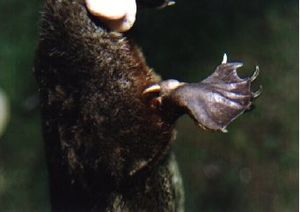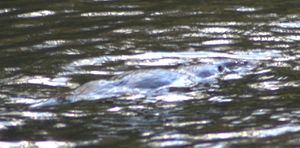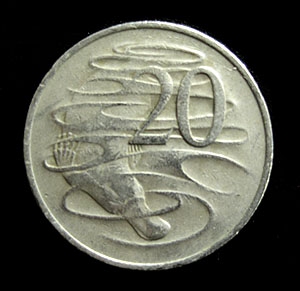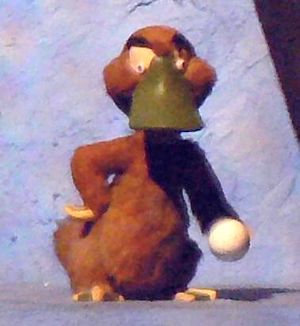خلد الماء
| خلد الماء Platypus[1] | |
|---|---|

| |
| التصنيف العلمي | |
| مملكة: | |
| Phylum: | |
| Class: | |
| Order: | |
| Family: | |
| Genus: | Ornithorhynchus Blumenbach, 1800
|
| Species: | O. anatinus
|
| Binomial name | |
| Ornithorhynchus anatinus (Shaw, 1799)
| |
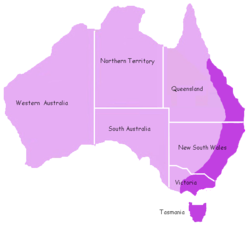
| |
| Platypus range (indicated by darker shading)[3] | |
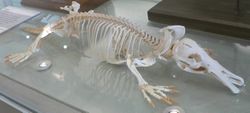
خُلد الماء بطي المنقار أو البلاتيبوس وهو حيوان ثديي ذو دم حار وفقاري ولكنه يبيض ولا يلد ويرضع أطفاله, يعيش في قارة أوقيانوسيا على شواطئ البحيرات والأنهار.
يغطي جسم خلد الماء فرو مثل ثعلب الماء وفي رأسه فم على شكل منقار مثل البط وله ذنب مثل القندس, ومنقاره هذا لحمي لين حساس جدا وليس كما هو لدى الطيور والبط, له مخرجا خلفيا واحدا مثلما هو الحال لدى الطيور, وله رجلان عريضتان مفلطحتان لها غطاء جلدي تساعده كثيرا في السباحة, كما له أظافر يستطيع الحفر بها, كما تتسلح تجاه أعدائها بسلاح سام.
يأكل القريدس (الروبيان) والكائنات المائية الصغيرة كالبزاق (نوع من الحلزونات) والقشريات والأسماك الصغيرة والضفادع والديدان.
يحفر منقار البط جحره على ضفاف الأنهار و يبلغ طول النفق عدة أمتار تصل إلى عشرة أمتار, ويعيش زوجا منقار البط معا بعد التزاوج في فصل الخريف, تترك أنثى منقار البط الجحر وتحفر لنفسها نفقا خاصا بها في آخره غرفة لوضع البيض تضع الأنثى فيها بيضتين أو ثلاث, يفقس البيض بعد عشرة أيام .
ترضع الأنثى صغارها من غدد للحليب توجد على بطن الأنثى تعمل عمل الحلمات.
تعتني الأنثى بصغارها وحمايتها من أعدائها ففي كل مرة تخرج الأنثى للبحث عن طعام تسد مدخل النفق بالتراب كي تموه على أعدائها كي لا تصل إلى صغارها ويستمر ذلك إلى حوالي أربعة أشهر إلى أن تنمو وتصبح قادرة في الاعتماد على نفسها.
يتزاوج خلد الماء وتخصب الأنثى مرة أخرى بعد ولادة صغارها إلا أن البيض لا يبدأ بالنمو إلا بعد أن ينتهي موسم إرضاع الصغار الذين هم في طور النمو.

. . . . . . . . . . . . . . . . . . . . . . . . . . . . . . . . . . . . . . . . . . . . . . . . . . . . . . . . . . . . . . . . . . . . . . . . . . . . . . . . . . . . . . . . . . . . . . . . . . . . . . . . . . . . . . . . . . . . . . . . . . . . . . . . . . . . . . . . . . . . . . . . . . . . . . . . . . . . . . . . . . . . . . . .
السم
 مقالة مفصلة: سم خلد الماء
مقالة مفصلة: سم خلد الماء
The male Platypus has ankle spurs which produce a cocktail of venom, composed largely of defensin-like proteins (DLPs), which is unique to the Platypus.[4] Although powerful enough to kill smaller animals,[4] the venom is not lethal to humans, but is so excruciating that the victim may be incapacitated. Oedema rapidly develops around the wound and gradually spreads throughout the affected limb. Information obtained from case histories and anecdotal evidence indicates that the pain develops into a long-lasting hyperalgesia that persists for days or even months.[5][6] Venom is produced in the crural glands of the male, which are kidney-shaped alveolar glands connected by a thin-walled duct to a calcaneus spur on each hind limb. The female Platypus, in common with echidnas, has rudimentary spur buds which do not develop (dropping off before the end of their first year) and lack functional crural glands.[7]
The venom appears to have a different function from those produced by non-mammalian species: its effects are non-life threatening but nevertheless powerful enough to seriously impair the victim. Since only males produce venom and production rises during the breeding season it is theorized that it is used as an offensive weapon to assert dominance during this period.[4]
Electrolocation
Monotremes are the only mammals known to have a sense of electroreception: they locate their prey in part by detecting electric fields generated by muscular contractions. The Platypus' electroreception is the most sensitive of any monotreme.[8]
Ecology and behaviour
The Platypus is semi-aquatic, inhabiting small streams and rivers over an extensive range from the cold highlands of Tasmania and the Australian Alps to the tropical rainforests of coastal Queensland as far north as the base of the Cape York Peninsula.[9] Inland, its distribution is not well known: it is extinct in South Australia (barring an introduced population on Kangaroo Island)[10] and is no longer found in the main part of the Murray-Darling Basin, possibly due to the declining water quality brought about by extensive land clearing and irrigation schemes.[11] Along the coastal river systems, its distribution is unpredictable; it appears to be absent from some relatively healthy rivers, and yet maintains a presence in others that are quite degraded (the lower Maribyrnong, for example).[12]
التكاثر
When the Platypus was first discovered scientists were divided over whether the female laid eggs. This was not confirmed until 1884 when W.H. Caldwell was sent to Australia where, after extensive searching assisted by a team of 150 Aborigines, he managed to discover a few eggs.[7][4] Mindful of the high cost of wiring England based on the cost per word, Caldwell famously but tersely wired لندن, "Monotremes oviparous, ovum meroblastic." That is, monotremes lay eggs, and the eggs are similar to those of reptiles in that only part of the egg divides as it develops.
في نشوء الثدييات
The Platypus and other monotremes were very poorly understood and some of the 19th century myths that grew up around them, for example, that the monotremes were "inferior" or quasi-reptilian, still endure.[13] In fact, modern monotremes are the survivors of an early branching of the mammal tree; a later branching is thought to have led to the marsupial and placental groups.[14][13] Although in 1947, William King Gregory had theorized that placental mammals and marsupials may have diverged earlier with a subsequent branching dividing the monotremes and marsupials, later research and fossil discoveries have suggested this is incorrect.[13][15]
حضوره في الثقافة
The Platypus is sometimes jokingly referred to as proof that God has a sense of humour (at the beginning of the film Dogma for example). Its unusual appearance has led to it featuring in many media, particularly in its native Australia.
The Platypus is featured on the Australian 20 cent coin, and has also been used several times as a mascot.
انظر أيضاً
هامش
- ^ Groves, C. P. (2005). Wilson, D. E.; Reeder, D. M (eds.). Mammal Species of the World (3rd ed.). Baltimore: Johns Hopkins University Press. p. 2. OCLC 62265494. ISBN 0-801-88221-4.
{{cite book}}: Invalid|ref=harv(help) - ^ Australasian Marsupial & Monotreme Specialist Group (1996). Ornithorhynchus anatinus. 2006 القائمة الحمراء للاتحاد العالمي للحفاظ على البيئة للأنواع المهددة. IUCN 2006. استرجعت في 09 May 2006. Database entry includes a brief justification of why this species is of least concern
- ^ "Platypus facts file". Australian Platypus Conservancy. Retrieved 13 September.
{{cite web}}: Check date values in:|accessdate=(help); Unknown parameter|accessyear=ignored (|access-date=suggested) (help) - ^ أ ب ت ث Gerritsen, Vivienne Baillie (2002-12). "Platypus poison". Protein Spotlight (29). Retrieved 14 September.
{{cite journal}}: Check date values in:|accessdate=and|date=(help); Unknown parameter|accessyear=ignored (|access-date=suggested) (help) - ^ G. M. de Plater, P. J. Milburn and R. L. Martin (2001-3). "Venom From the Platypus, Ornithorhynchus anatinus, Induces a Calcium-Dependent Current in Cultured Dorsal Root Ganglion Cells". Journal of Neurophysiology. American Physiological Society. 85 (3): 1340–1345.
{{cite journal}}: Check date values in:|date=(help) - ^ "The venom of the platypus (Ornithorhynchus anatinus)".
{{cite web}}: Unknown parameter|accessdaymonth=ignored (help); Unknown parameter|accessyear=ignored (|access-date=suggested) (help) - ^ أ ب خطأ استشهاد: وسم
<ref>غير صحيح؛ لا نص تم توفيره للمراجع المسماةABRS - ^ Pettigrew, John D. (1999). "Electroreception in Monotremes" (PDF). The Journal of Experimental Biology (202): 1447–1454. Retrieved 19 September.
{{cite journal}}: Check date values in:|accessdate=(help); Unknown parameter|accessyear=ignored (|access-date=suggested) (help) - ^ "Platypus". Department of Primary Industries and Water, Tasmania. 2006-08-31.
{{cite web}}: Unknown parameter|accessdaymonth=ignored (help); Unknown parameter|accessyear=ignored (|access-date=suggested) (help) - ^ "Research on Kangaroo Island". University of Adelaide. 2006-07-04.
{{cite web}}: Unknown parameter|accessdaymonth=ignored (help); Unknown parameter|accessyear=ignored (|access-date=suggested) (help) - ^ Anthony Scott and Tom Grant (1997-11). "Impacts of water management in the Murray-Darling Basin on the platypus (Ornithorhynchus anatinus) and the water rat (Hydromus chrysogaster)" (PDF). CSIRO Australia.
{{cite web}}: Check date values in:|date=(help); Unknown parameter|accessdaymonth=ignored (help); Unknown parameter|accessyear=ignored (|access-date=suggested) (help) - ^ "Platypus in Country Areas". Australian Platypus Conservancy.
{{cite web}}: Unknown parameter|accessdaymonth=ignored (help); Unknown parameter|accessyear=ignored (|access-date=suggested) (help) - ^ أ ب ت John A. W. Kirsch and Gregory C. Mayer (1998-07-29). "The Platypus is not a Rodent: DNA Hybridization, Amniote Phylogeny and the Palimpsest Theory". Philosophical Transactions: Biological Sciences. 353 (1372): 1221–1237.
- ^ M. Messer, A.S. Weiss, D.C. Shaw and M. Westerman (1998-03). "Evolution of the Monotremes: Phylogenetic Relationship to Marsupials and Eutherians, and Estimation of Divergence Dates Based on α-Lactalbumin Amino Acid Sequences". Journal of Mammalian Evolution. Springer Netherlands. 5 (1): 95–105. doi:10.1023/A:1020523120739.
{{cite journal}}: Check date values in:|date=(help)CS1 maint: multiple names: authors list (link) - ^ O. W. M. Rauhut, T. Martin, E. Ortiz-Jaureguizar and P. Puerta (2001-12-11). "The first Jurassic mammal from South America". Nature.
{{cite web}}: Unknown parameter|accessdaymonth=ignored (help); Unknown parameter|accessyear=ignored (|access-date=suggested) (help)CS1 maint: multiple names: authors list (link)
المصادر
- كتب
- Augee, Michael L. Platypus. World Book Encyclopedia. 2001 ed.
- Burrell, H. The Platypus. Adelaide: Rigby, 1974.
- Marshall, Ben "The Amazing Duckbilled Platypus" New York Publishers Inc. 2002 ed
- Grant, Tom. The platypus: a unique mammal. Sydney: University of New South Wales Press, 1995. ISBN 0-86840-143-9.
- Griffiths, Mervyn. The Biology of the Monotremes. Academic Press, 1978.
- Michael Hutch, Melissa C. McDade, eds. Grzimek's Animal Life Encyclopedia; Volume 12. Detroit: Gale, 2004.
- Moyal, Ann. Platypus: The Extraordinary Story of How a Curious Creature Baffled the World. Smithsonian Books, 2001. ISBN 1-56098-977-7.
- Strahan, R. The Mammals of Australia. New South Wales: Reed Books, 1995.
- أفلام تسجيلية
- Eye of the Storm. Documentary by the Australian Broadcasting Corporation.



